Business Law Assignment: Contract, Sales, and Promissory Estoppel
VerifiedAdded on 2022/11/14
|8
|1628
|103
Homework Assignment
AI Summary
This business law assignment addresses several key legal issues related to sales contracts and business practices. The first question examines whether statements made during a sale are considered part of the contract, differentiating between opinions, puffs, representations, and terms of the contract. The second question explores the validity of exclusion clauses, focusing on the importance of visibility and awareness for the buyer. The third question analyzes the application of promissory estoppel, particularly in an unwritten agreement scenario. Finally, the assignment considers the enforceability of exclusion clauses placed on receipts, emphasizing the need for client awareness. The assignment draws upon relevant case law and legal principles to provide a comprehensive analysis of the issues.
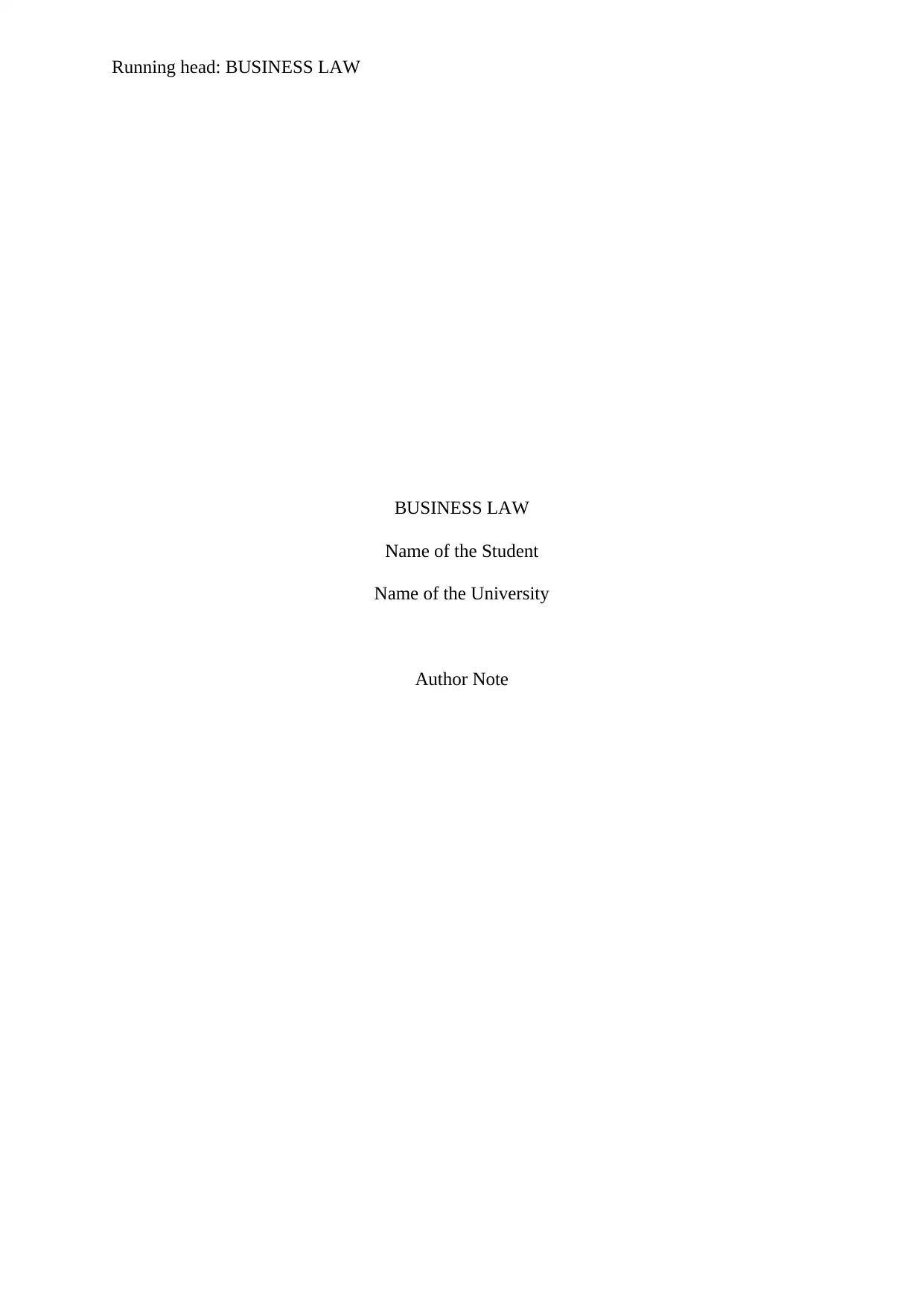
Running head: BUSINESS LAW
BUSINESS LAW
Name of the Student
Name of the University
Author Note
BUSINESS LAW
Name of the Student
Name of the University
Author Note
Paraphrase This Document
Need a fresh take? Get an instant paraphrase of this document with our AI Paraphraser
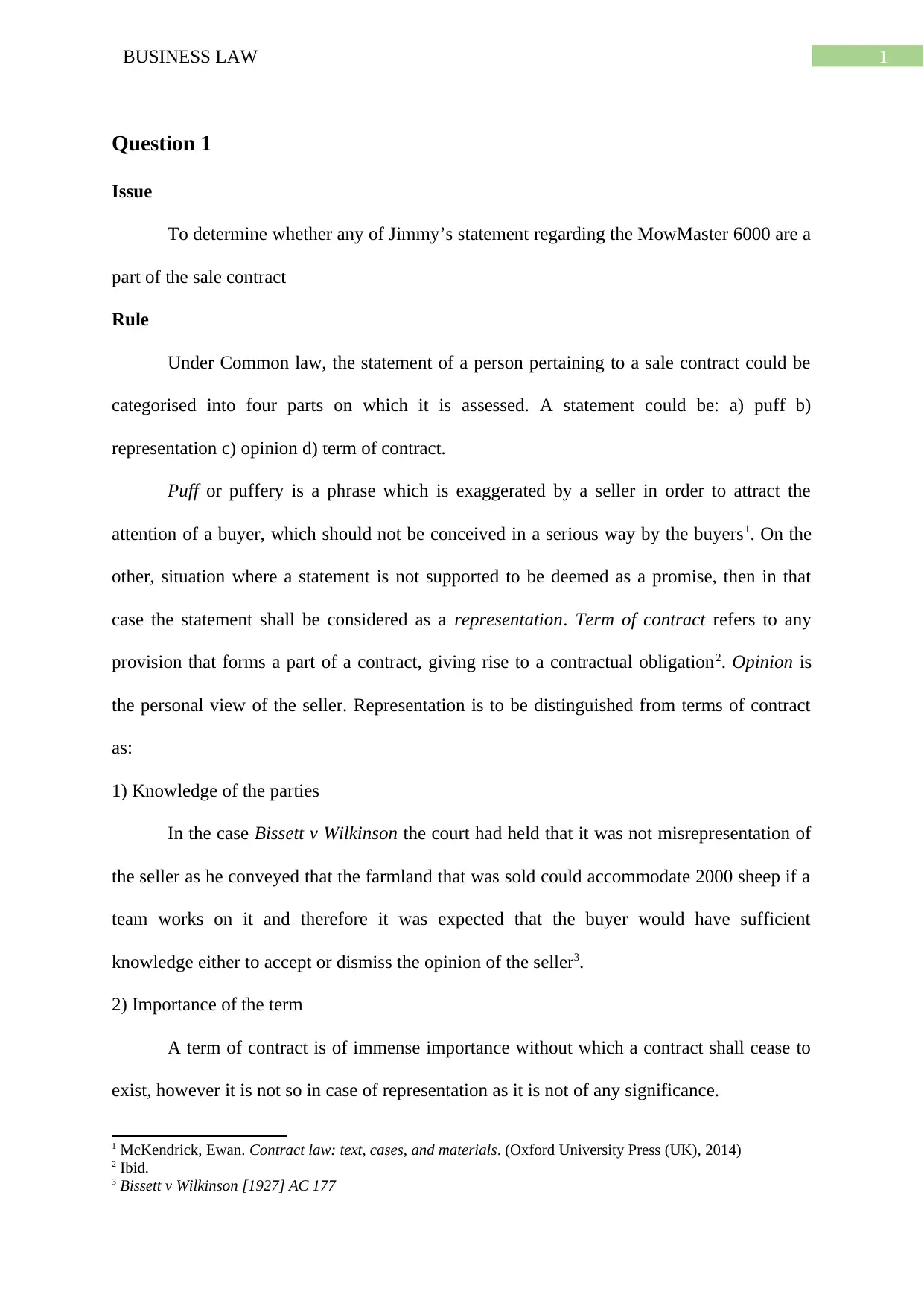
1BUSINESS LAW
Question 1
Issue
To determine whether any of Jimmy’s statement regarding the MowMaster 6000 are a
part of the sale contract
Rule
Under Common law, the statement of a person pertaining to a sale contract could be
categorised into four parts on which it is assessed. A statement could be: a) puff b)
representation c) opinion d) term of contract.
Puff or puffery is a phrase which is exaggerated by a seller in order to attract the
attention of a buyer, which should not be conceived in a serious way by the buyers1. On the
other, situation where a statement is not supported to be deemed as a promise, then in that
case the statement shall be considered as a representation. Term of contract refers to any
provision that forms a part of a contract, giving rise to a contractual obligation2. Opinion is
the personal view of the seller. Representation is to be distinguished from terms of contract
as:
1) Knowledge of the parties
In the case Bissett v Wilkinson the court had held that it was not misrepresentation of
the seller as he conveyed that the farmland that was sold could accommodate 2000 sheep if a
team works on it and therefore it was expected that the buyer would have sufficient
knowledge either to accept or dismiss the opinion of the seller3.
2) Importance of the term
A term of contract is of immense importance without which a contract shall cease to
exist, however it is not so in case of representation as it is not of any significance.
1 McKendrick, Ewan. Contract law: text, cases, and materials. (Oxford University Press (UK), 2014)
2 Ibid.
3 Bissett v Wilkinson [1927] AC 177
Question 1
Issue
To determine whether any of Jimmy’s statement regarding the MowMaster 6000 are a
part of the sale contract
Rule
Under Common law, the statement of a person pertaining to a sale contract could be
categorised into four parts on which it is assessed. A statement could be: a) puff b)
representation c) opinion d) term of contract.
Puff or puffery is a phrase which is exaggerated by a seller in order to attract the
attention of a buyer, which should not be conceived in a serious way by the buyers1. On the
other, situation where a statement is not supported to be deemed as a promise, then in that
case the statement shall be considered as a representation. Term of contract refers to any
provision that forms a part of a contract, giving rise to a contractual obligation2. Opinion is
the personal view of the seller. Representation is to be distinguished from terms of contract
as:
1) Knowledge of the parties
In the case Bissett v Wilkinson the court had held that it was not misrepresentation of
the seller as he conveyed that the farmland that was sold could accommodate 2000 sheep if a
team works on it and therefore it was expected that the buyer would have sufficient
knowledge either to accept or dismiss the opinion of the seller3.
2) Importance of the term
A term of contract is of immense importance without which a contract shall cease to
exist, however it is not so in case of representation as it is not of any significance.
1 McKendrick, Ewan. Contract law: text, cases, and materials. (Oxford University Press (UK), 2014)
2 Ibid.
3 Bissett v Wilkinson [1927] AC 177
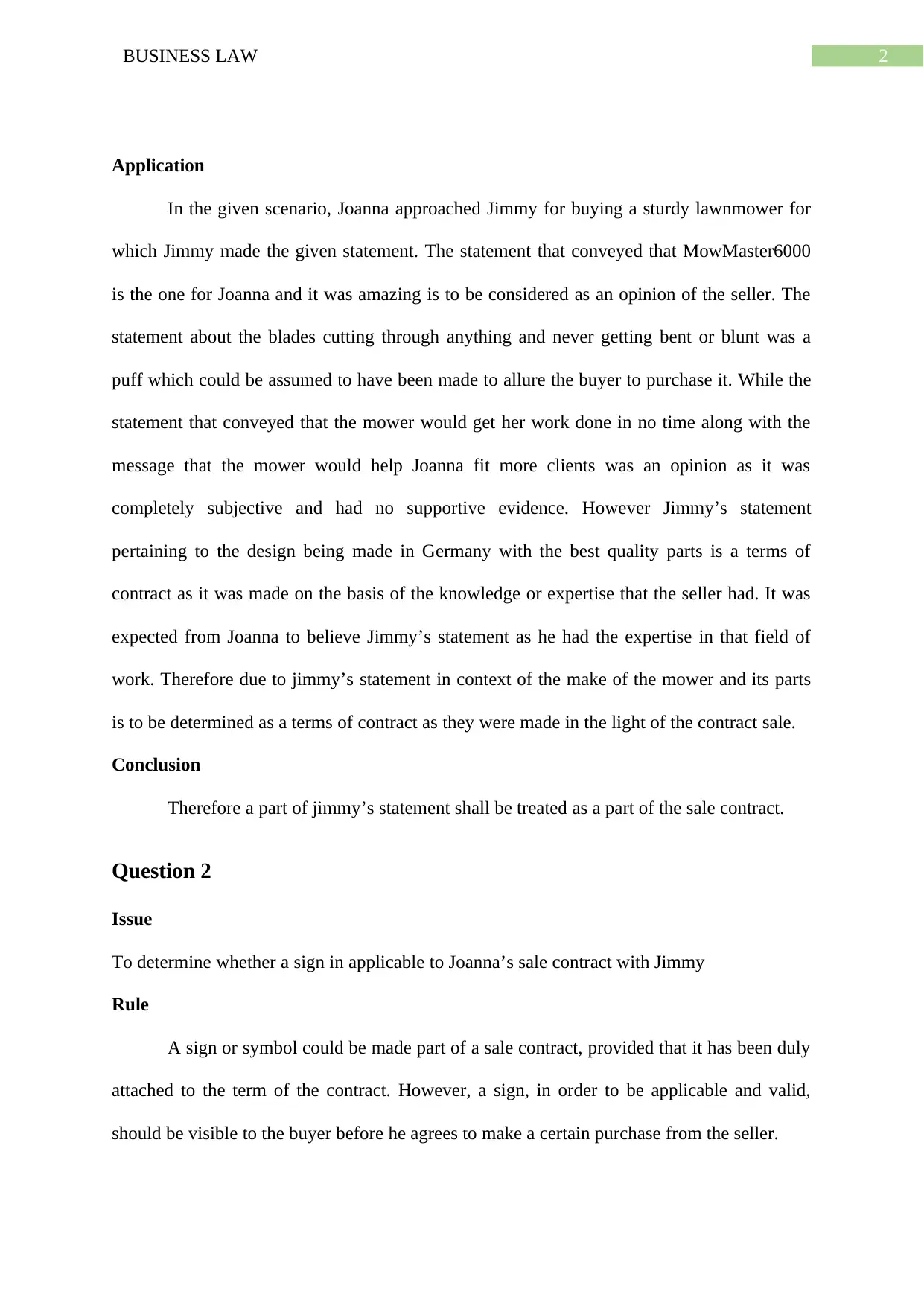
2BUSINESS LAW
Application
In the given scenario, Joanna approached Jimmy for buying a sturdy lawnmower for
which Jimmy made the given statement. The statement that conveyed that MowMaster6000
is the one for Joanna and it was amazing is to be considered as an opinion of the seller. The
statement about the blades cutting through anything and never getting bent or blunt was a
puff which could be assumed to have been made to allure the buyer to purchase it. While the
statement that conveyed that the mower would get her work done in no time along with the
message that the mower would help Joanna fit more clients was an opinion as it was
completely subjective and had no supportive evidence. However Jimmy’s statement
pertaining to the design being made in Germany with the best quality parts is a terms of
contract as it was made on the basis of the knowledge or expertise that the seller had. It was
expected from Joanna to believe Jimmy’s statement as he had the expertise in that field of
work. Therefore due to jimmy’s statement in context of the make of the mower and its parts
is to be determined as a terms of contract as they were made in the light of the contract sale.
Conclusion
Therefore a part of jimmy’s statement shall be treated as a part of the sale contract.
Question 2
Issue
To determine whether a sign in applicable to Joanna’s sale contract with Jimmy
Rule
A sign or symbol could be made part of a sale contract, provided that it has been duly
attached to the term of the contract. However, a sign, in order to be applicable and valid,
should be visible to the buyer before he agrees to make a certain purchase from the seller.
Application
In the given scenario, Joanna approached Jimmy for buying a sturdy lawnmower for
which Jimmy made the given statement. The statement that conveyed that MowMaster6000
is the one for Joanna and it was amazing is to be considered as an opinion of the seller. The
statement about the blades cutting through anything and never getting bent or blunt was a
puff which could be assumed to have been made to allure the buyer to purchase it. While the
statement that conveyed that the mower would get her work done in no time along with the
message that the mower would help Joanna fit more clients was an opinion as it was
completely subjective and had no supportive evidence. However Jimmy’s statement
pertaining to the design being made in Germany with the best quality parts is a terms of
contract as it was made on the basis of the knowledge or expertise that the seller had. It was
expected from Joanna to believe Jimmy’s statement as he had the expertise in that field of
work. Therefore due to jimmy’s statement in context of the make of the mower and its parts
is to be determined as a terms of contract as they were made in the light of the contract sale.
Conclusion
Therefore a part of jimmy’s statement shall be treated as a part of the sale contract.
Question 2
Issue
To determine whether a sign in applicable to Joanna’s sale contract with Jimmy
Rule
A sign or symbol could be made part of a sale contract, provided that it has been duly
attached to the term of the contract. However, a sign, in order to be applicable and valid,
should be visible to the buyer before he agrees to make a certain purchase from the seller.
⊘ This is a preview!⊘
Do you want full access?
Subscribe today to unlock all pages.

Trusted by 1+ million students worldwide
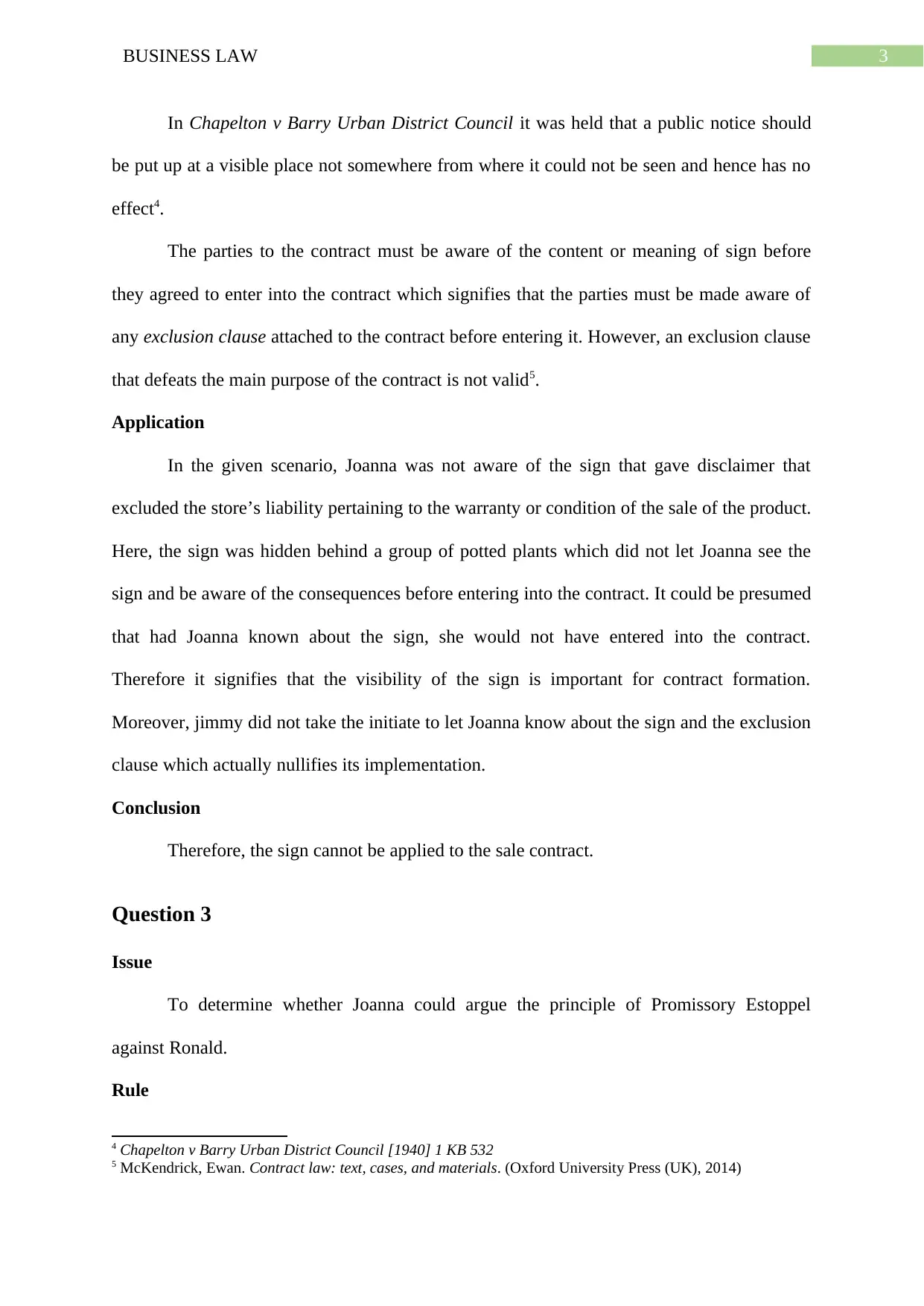
3BUSINESS LAW
In Chapelton v Barry Urban District Council it was held that a public notice should
be put up at a visible place not somewhere from where it could not be seen and hence has no
effect4.
The parties to the contract must be aware of the content or meaning of sign before
they agreed to enter into the contract which signifies that the parties must be made aware of
any exclusion clause attached to the contract before entering it. However, an exclusion clause
that defeats the main purpose of the contract is not valid5.
Application
In the given scenario, Joanna was not aware of the sign that gave disclaimer that
excluded the store’s liability pertaining to the warranty or condition of the sale of the product.
Here, the sign was hidden behind a group of potted plants which did not let Joanna see the
sign and be aware of the consequences before entering into the contract. It could be presumed
that had Joanna known about the sign, she would not have entered into the contract.
Therefore it signifies that the visibility of the sign is important for contract formation.
Moreover, jimmy did not take the initiate to let Joanna know about the sign and the exclusion
clause which actually nullifies its implementation.
Conclusion
Therefore, the sign cannot be applied to the sale contract.
Question 3
Issue
To determine whether Joanna could argue the principle of Promissory Estoppel
against Ronald.
Rule
4 Chapelton v Barry Urban District Council [1940] 1 KB 532
5 McKendrick, Ewan. Contract law: text, cases, and materials. (Oxford University Press (UK), 2014)
In Chapelton v Barry Urban District Council it was held that a public notice should
be put up at a visible place not somewhere from where it could not be seen and hence has no
effect4.
The parties to the contract must be aware of the content or meaning of sign before
they agreed to enter into the contract which signifies that the parties must be made aware of
any exclusion clause attached to the contract before entering it. However, an exclusion clause
that defeats the main purpose of the contract is not valid5.
Application
In the given scenario, Joanna was not aware of the sign that gave disclaimer that
excluded the store’s liability pertaining to the warranty or condition of the sale of the product.
Here, the sign was hidden behind a group of potted plants which did not let Joanna see the
sign and be aware of the consequences before entering into the contract. It could be presumed
that had Joanna known about the sign, she would not have entered into the contract.
Therefore it signifies that the visibility of the sign is important for contract formation.
Moreover, jimmy did not take the initiate to let Joanna know about the sign and the exclusion
clause which actually nullifies its implementation.
Conclusion
Therefore, the sign cannot be applied to the sale contract.
Question 3
Issue
To determine whether Joanna could argue the principle of Promissory Estoppel
against Ronald.
Rule
4 Chapelton v Barry Urban District Council [1940] 1 KB 532
5 McKendrick, Ewan. Contract law: text, cases, and materials. (Oxford University Press (UK), 2014)
Paraphrase This Document
Need a fresh take? Get an instant paraphrase of this document with our AI Paraphraser
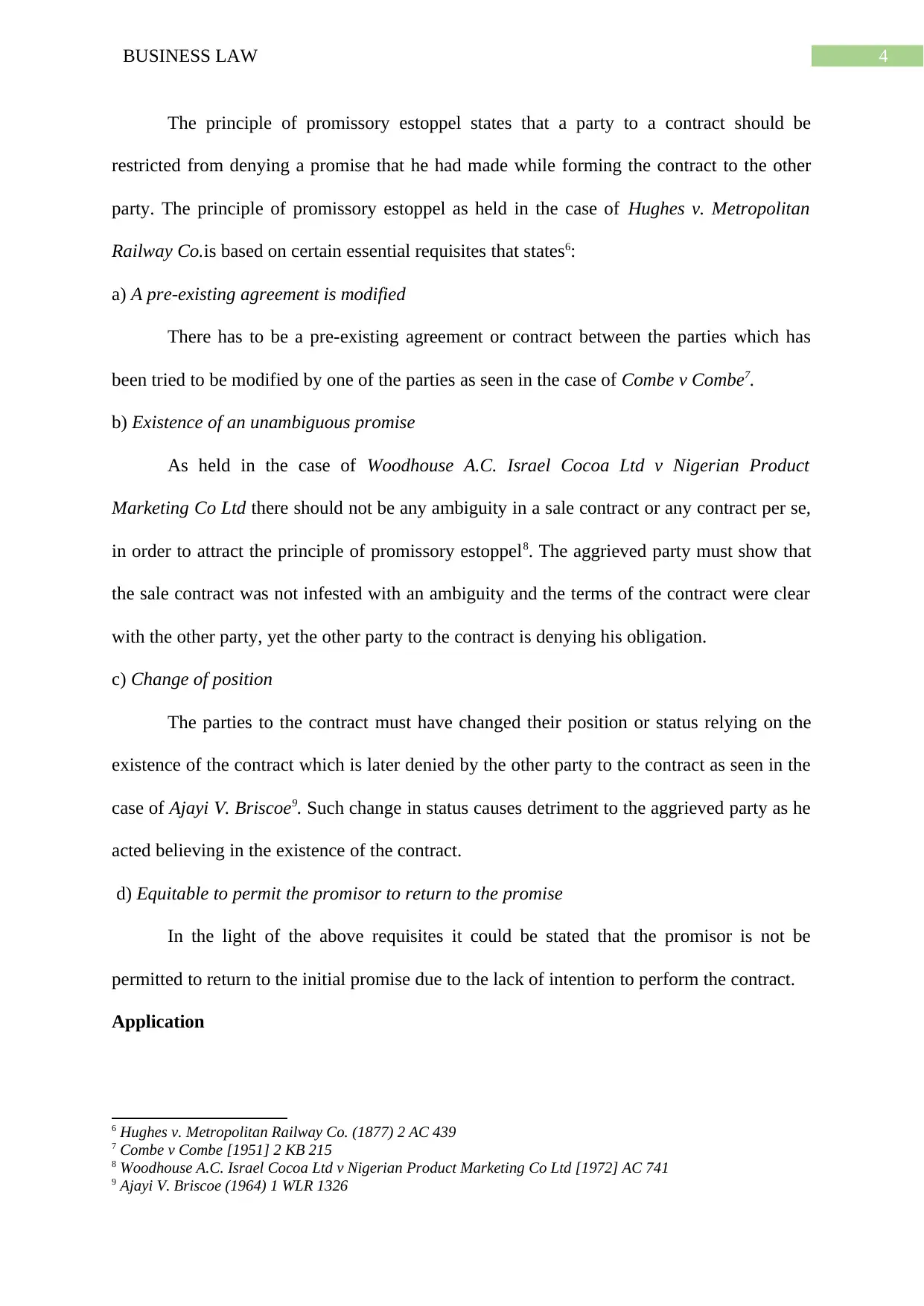
4BUSINESS LAW
The principle of promissory estoppel states that a party to a contract should be
restricted from denying a promise that he had made while forming the contract to the other
party. The principle of promissory estoppel as held in the case of Hughes v. Metropolitan
Railway Co.is based on certain essential requisites that states6:
a) A pre-existing agreement is modified
There has to be a pre-existing agreement or contract between the parties which has
been tried to be modified by one of the parties as seen in the case of Combe v Combe7.
b) Existence of an unambiguous promise
As held in the case of Woodhouse A.C. Israel Cocoa Ltd v Nigerian Product
Marketing Co Ltd there should not be any ambiguity in a sale contract or any contract per se,
in order to attract the principle of promissory estoppel8. The aggrieved party must show that
the sale contract was not infested with an ambiguity and the terms of the contract were clear
with the other party, yet the other party to the contract is denying his obligation.
c) Change of position
The parties to the contract must have changed their position or status relying on the
existence of the contract which is later denied by the other party to the contract as seen in the
case of Ajayi V. Briscoe9. Such change in status causes detriment to the aggrieved party as he
acted believing in the existence of the contract.
d) Equitable to permit the promisor to return to the promise
In the light of the above requisites it could be stated that the promisor is not be
permitted to return to the initial promise due to the lack of intention to perform the contract.
Application
6 Hughes v. Metropolitan Railway Co. (1877) 2 AC 439
7 Combe v Combe [1951] 2 KB 215
8 Woodhouse A.C. Israel Cocoa Ltd v Nigerian Product Marketing Co Ltd [1972] AC 741
9 Ajayi V. Briscoe (1964) 1 WLR 1326
The principle of promissory estoppel states that a party to a contract should be
restricted from denying a promise that he had made while forming the contract to the other
party. The principle of promissory estoppel as held in the case of Hughes v. Metropolitan
Railway Co.is based on certain essential requisites that states6:
a) A pre-existing agreement is modified
There has to be a pre-existing agreement or contract between the parties which has
been tried to be modified by one of the parties as seen in the case of Combe v Combe7.
b) Existence of an unambiguous promise
As held in the case of Woodhouse A.C. Israel Cocoa Ltd v Nigerian Product
Marketing Co Ltd there should not be any ambiguity in a sale contract or any contract per se,
in order to attract the principle of promissory estoppel8. The aggrieved party must show that
the sale contract was not infested with an ambiguity and the terms of the contract were clear
with the other party, yet the other party to the contract is denying his obligation.
c) Change of position
The parties to the contract must have changed their position or status relying on the
existence of the contract which is later denied by the other party to the contract as seen in the
case of Ajayi V. Briscoe9. Such change in status causes detriment to the aggrieved party as he
acted believing in the existence of the contract.
d) Equitable to permit the promisor to return to the promise
In the light of the above requisites it could be stated that the promisor is not be
permitted to return to the initial promise due to the lack of intention to perform the contract.
Application
6 Hughes v. Metropolitan Railway Co. (1877) 2 AC 439
7 Combe v Combe [1951] 2 KB 215
8 Woodhouse A.C. Israel Cocoa Ltd v Nigerian Product Marketing Co Ltd [1972] AC 741
9 Ajayi V. Briscoe (1964) 1 WLR 1326
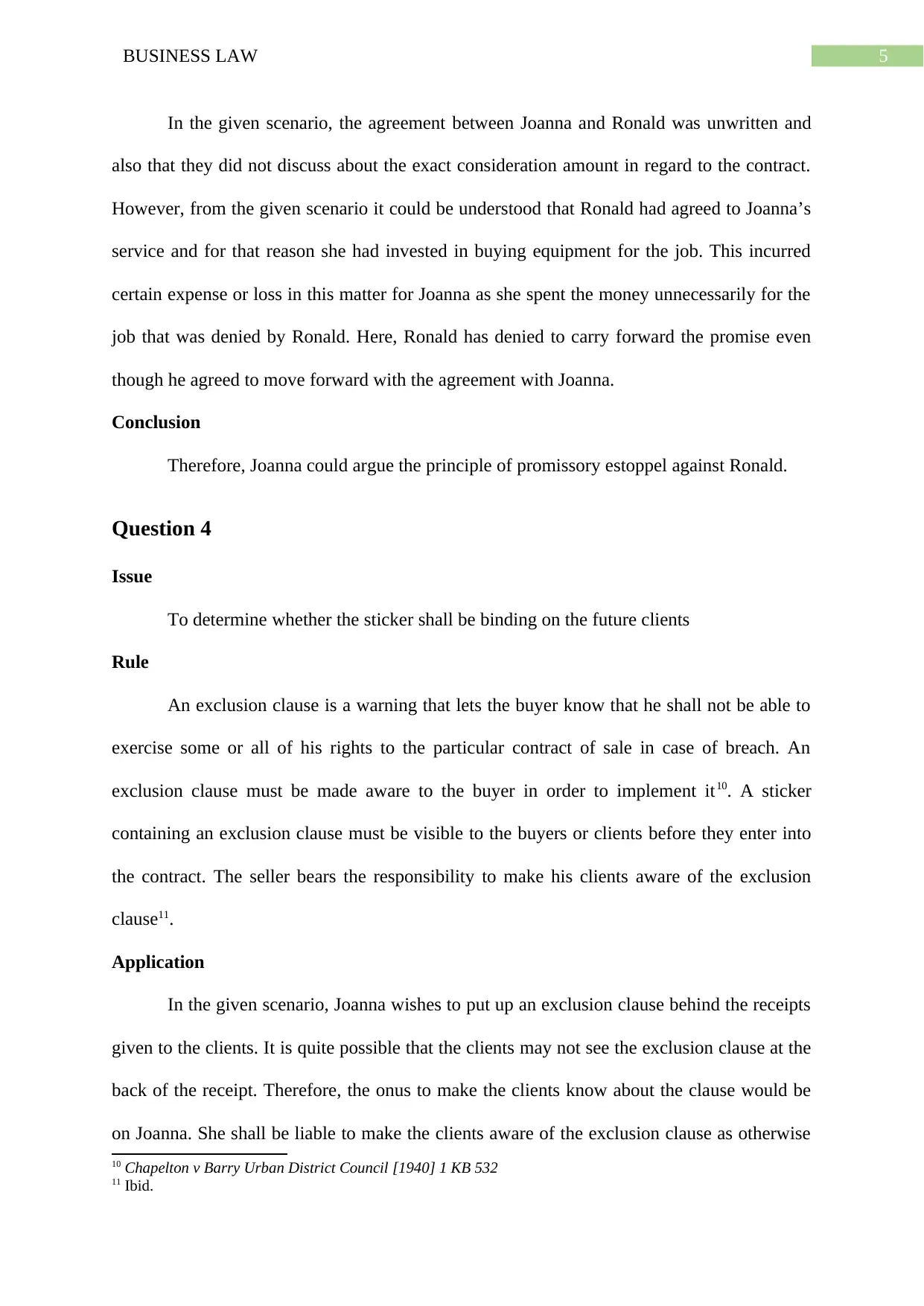
5BUSINESS LAW
In the given scenario, the agreement between Joanna and Ronald was unwritten and
also that they did not discuss about the exact consideration amount in regard to the contract.
However, from the given scenario it could be understood that Ronald had agreed to Joanna’s
service and for that reason she had invested in buying equipment for the job. This incurred
certain expense or loss in this matter for Joanna as she spent the money unnecessarily for the
job that was denied by Ronald. Here, Ronald has denied to carry forward the promise even
though he agreed to move forward with the agreement with Joanna.
Conclusion
Therefore, Joanna could argue the principle of promissory estoppel against Ronald.
Question 4
Issue
To determine whether the sticker shall be binding on the future clients
Rule
An exclusion clause is a warning that lets the buyer know that he shall not be able to
exercise some or all of his rights to the particular contract of sale in case of breach. An
exclusion clause must be made aware to the buyer in order to implement it10. A sticker
containing an exclusion clause must be visible to the buyers or clients before they enter into
the contract. The seller bears the responsibility to make his clients aware of the exclusion
clause11.
Application
In the given scenario, Joanna wishes to put up an exclusion clause behind the receipts
given to the clients. It is quite possible that the clients may not see the exclusion clause at the
back of the receipt. Therefore, the onus to make the clients know about the clause would be
on Joanna. She shall be liable to make the clients aware of the exclusion clause as otherwise
10 Chapelton v Barry Urban District Council [1940] 1 KB 532
11 Ibid.
In the given scenario, the agreement between Joanna and Ronald was unwritten and
also that they did not discuss about the exact consideration amount in regard to the contract.
However, from the given scenario it could be understood that Ronald had agreed to Joanna’s
service and for that reason she had invested in buying equipment for the job. This incurred
certain expense or loss in this matter for Joanna as she spent the money unnecessarily for the
job that was denied by Ronald. Here, Ronald has denied to carry forward the promise even
though he agreed to move forward with the agreement with Joanna.
Conclusion
Therefore, Joanna could argue the principle of promissory estoppel against Ronald.
Question 4
Issue
To determine whether the sticker shall be binding on the future clients
Rule
An exclusion clause is a warning that lets the buyer know that he shall not be able to
exercise some or all of his rights to the particular contract of sale in case of breach. An
exclusion clause must be made aware to the buyer in order to implement it10. A sticker
containing an exclusion clause must be visible to the buyers or clients before they enter into
the contract. The seller bears the responsibility to make his clients aware of the exclusion
clause11.
Application
In the given scenario, Joanna wishes to put up an exclusion clause behind the receipts
given to the clients. It is quite possible that the clients may not see the exclusion clause at the
back of the receipt. Therefore, the onus to make the clients know about the clause would be
on Joanna. She shall be liable to make the clients aware of the exclusion clause as otherwise
10 Chapelton v Barry Urban District Council [1940] 1 KB 532
11 Ibid.
⊘ This is a preview!⊘
Do you want full access?
Subscribe today to unlock all pages.

Trusted by 1+ million students worldwide
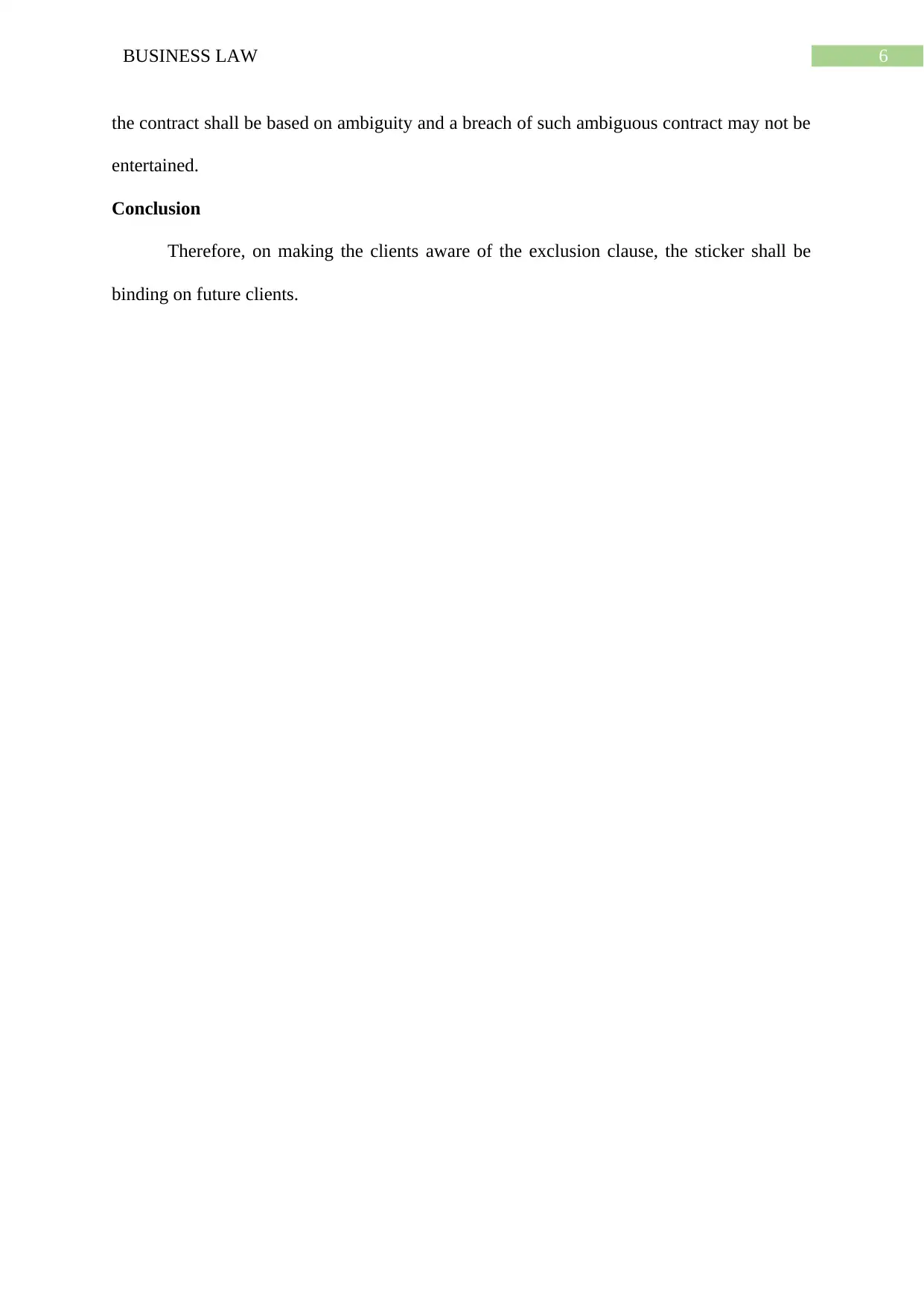
6BUSINESS LAW
the contract shall be based on ambiguity and a breach of such ambiguous contract may not be
entertained.
Conclusion
Therefore, on making the clients aware of the exclusion clause, the sticker shall be
binding on future clients.
the contract shall be based on ambiguity and a breach of such ambiguous contract may not be
entertained.
Conclusion
Therefore, on making the clients aware of the exclusion clause, the sticker shall be
binding on future clients.
Paraphrase This Document
Need a fresh take? Get an instant paraphrase of this document with our AI Paraphraser
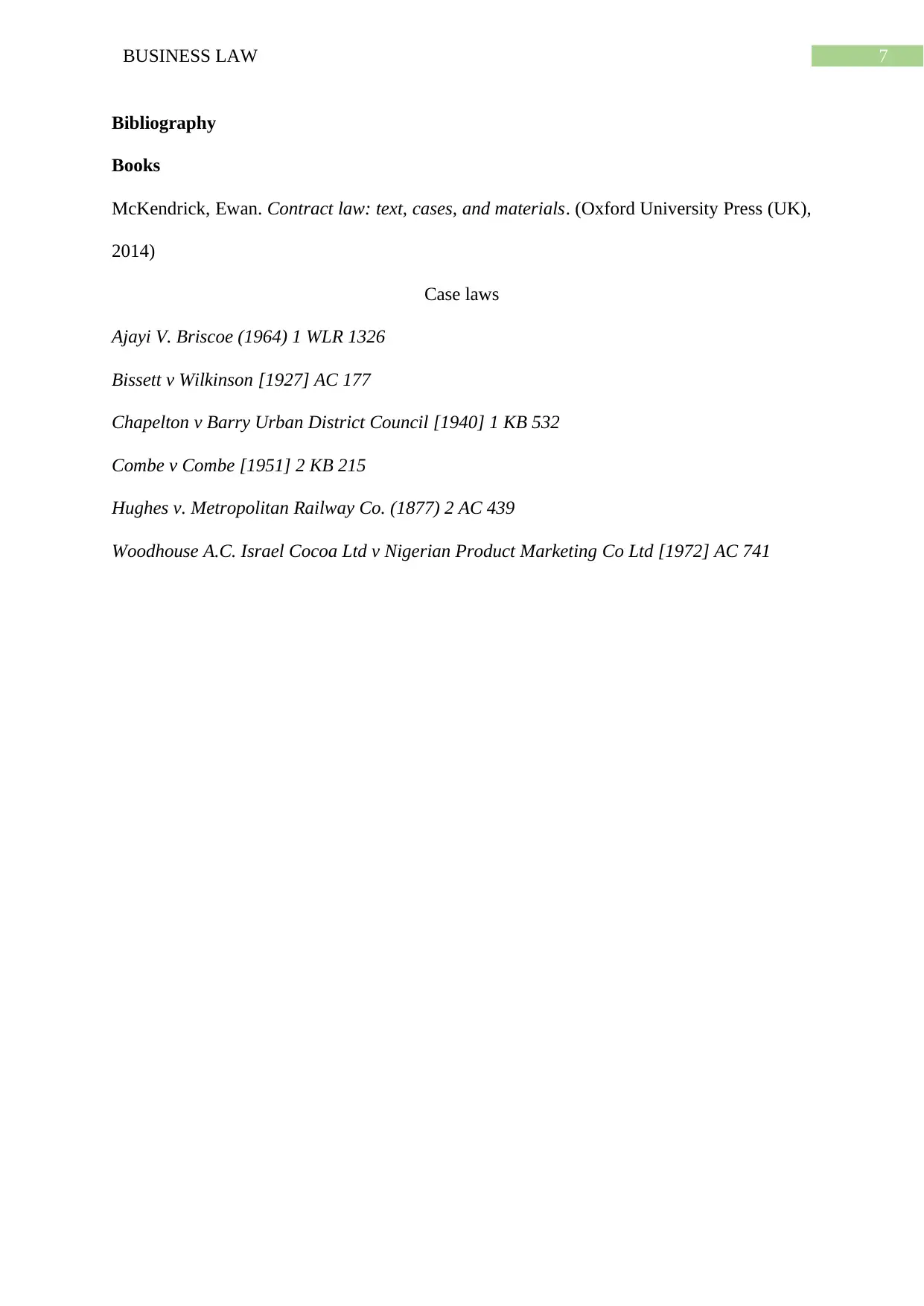
7BUSINESS LAW
Bibliography
Books
McKendrick, Ewan. Contract law: text, cases, and materials. (Oxford University Press (UK),
2014)
Case laws
Ajayi V. Briscoe (1964) 1 WLR 1326
Bissett v Wilkinson [1927] AC 177
Chapelton v Barry Urban District Council [1940] 1 KB 532
Combe v Combe [1951] 2 KB 215
Hughes v. Metropolitan Railway Co. (1877) 2 AC 439
Woodhouse A.C. Israel Cocoa Ltd v Nigerian Product Marketing Co Ltd [1972] AC 741
Bibliography
Books
McKendrick, Ewan. Contract law: text, cases, and materials. (Oxford University Press (UK),
2014)
Case laws
Ajayi V. Briscoe (1964) 1 WLR 1326
Bissett v Wilkinson [1927] AC 177
Chapelton v Barry Urban District Council [1940] 1 KB 532
Combe v Combe [1951] 2 KB 215
Hughes v. Metropolitan Railway Co. (1877) 2 AC 439
Woodhouse A.C. Israel Cocoa Ltd v Nigerian Product Marketing Co Ltd [1972] AC 741
1 out of 8
Related Documents
Your All-in-One AI-Powered Toolkit for Academic Success.
+13062052269
info@desklib.com
Available 24*7 on WhatsApp / Email
![[object Object]](/_next/static/media/star-bottom.7253800d.svg)
Unlock your academic potential
Copyright © 2020–2025 A2Z Services. All Rights Reserved. Developed and managed by ZUCOL.





![Detailed Case Analysis: Contract Law Issues in Business - [Module]](/_next/image/?url=https%3A%2F%2Fdesklib.com%2Fmedia%2Fimages%2Fbp%2F21fe1e6ab8ee47e1b904ddfd70315544.jpg&w=256&q=75)